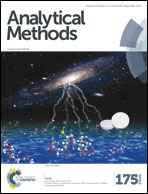A fluorescence anisotropy study of the DNA hybridization reaction mediated by formation of the C–Ag+–C structure†
Abstract
Fluorescence anisotropy is a simple and cost-effective method which can be performed in a homogeneous manner, providing simplicity for practical usage. As it originates from the rotational diffusion of the fluorophore associated entity, this method is sensitive to the volume and structural changes of the investigated molecule. In this contribution, fluorescence anisotropy was used to study the DNA hybridization mediated by the formation of the C–Ag+–C structure with silver ions at the nano-molar level. Factors influencing the structural stability of the formed duplex, including buffer composition, the length of the formed duplex, and percentage of C–C mismatches, were studied in detail. The reagent background signal can be reduced by using a hairpin-structured, partially complementary strand with C–C mismatched sites. Fluorescence anisotropy titration was used to estimate the formation constant of the C–Ag+–C structure involving DNA hybridization based on a 1 : 1 binding stoichiometry between Ag+ and the C–C mismatched site. A good fit to the Scatchard model indicated that each binding site interacted independently with Ag+. This study demonstrated that fluorescence anisotropy is a simple and effective approach to study the structural stability of the short DNA molecule, thus extending the breadth of applications of fluorescence anisotropy in DNA-based recognition.


 Please wait while we load your content...
Please wait while we load your content...